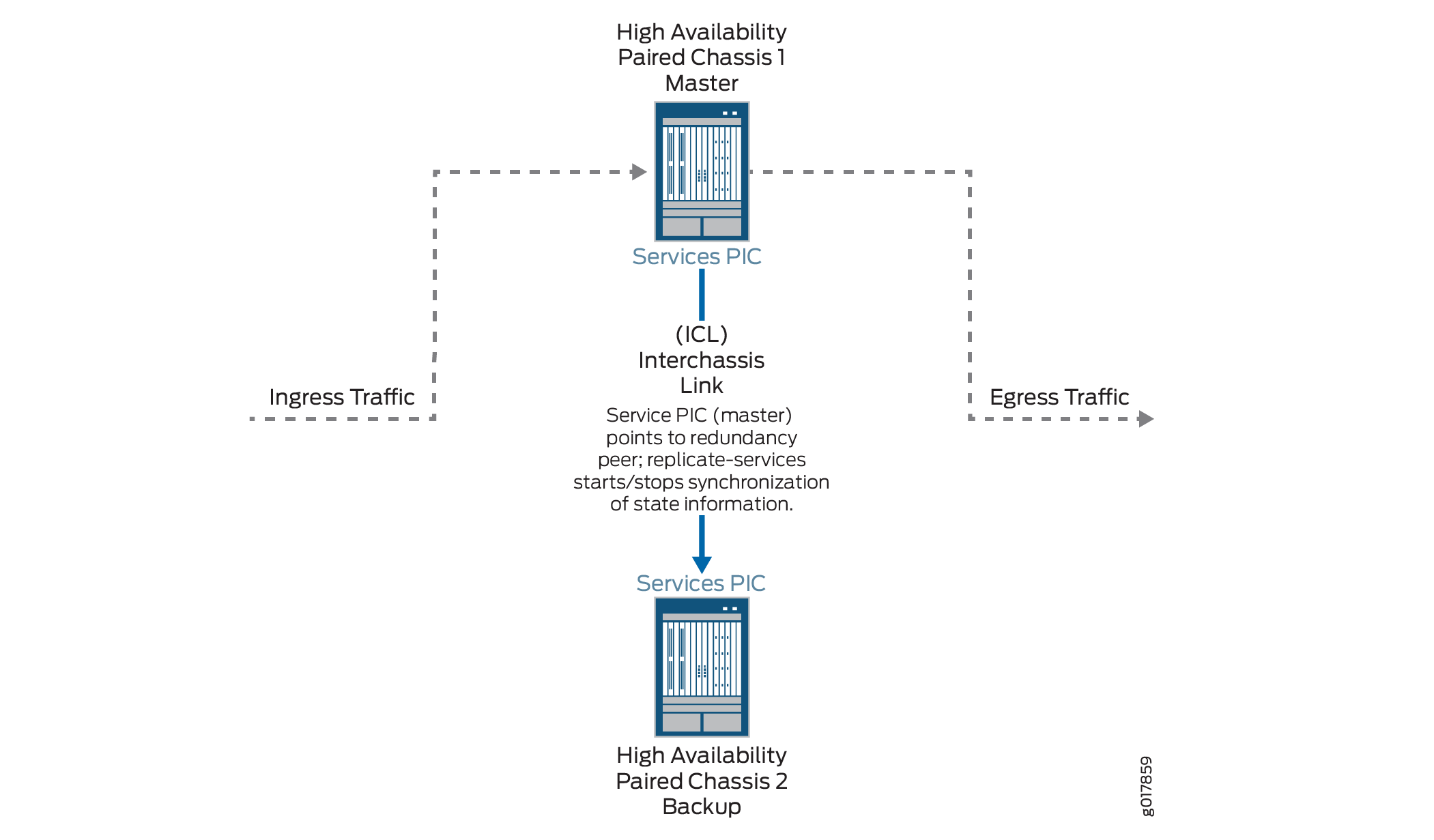- play_arrow Overview
- play_arrow Next Gen Services Overview
- play_arrow Configuration Overview
- Configuration Differences Between Adaptive Services and Next Gen Services on the MX-SPC3
- Next Gen Services Feature Configuration Overview
- How to Configure Services Interfaces for Next Gen Services
- How to Configure Interface-Style Service Sets for Next Gen Services
- How to Configure Next-Hop Style Service Sets for Next Gen Services
- How to Configure Service Set Limits for Next Gen Services
- Example: Next Gen Services Inter-Chassis Stateful High Availability for NAT and Stateful Firewall (MX-SPC3)
- Example: Configuring AutoVPN with Pre-Shared Key
- Enabling and Disabling Next Gen Services
- play_arrow Global System Logging Overview and Configuration
- Understanding Next Gen Services CGNAT Global System Logging
- Enabling Global System Logging for Next Gen Services
- Configuring Local System Logging for Next Gen Services
- Configuring System Logging to One or More Remote Servers for Next Gen Services
- System Log Error Messages for Next Gen Services
- Configuring Syslog Events for NAT Rule Conditions with Next Gen Services
- play_arrow Next Gen Services SNMP MIBS and Traps
-
- play_arrow Carrier Grade NAT (CGNAT)
- play_arrow Deterministic NAT Overview and Configuration
- play_arrow Dynamic Address-Only Source NAT Overview and Configuration
- play_arrow Network Address Port Translation Overview and Configuration
- play_arrow NAT46
- play_arrow Stateful NAT64 Overview and Configuration
- play_arrow IPv4 Connectivity Across IPv6-Only Network Using 464XLAT Overview and Configuration
- play_arrow IPv6 NAT Protocol Translation (NAT PT)
- play_arrow Stateless Source Network Prefix Translation for IPv6 Overview and Configuration
- play_arrow Transitioning to IPv6 Using Softwires
- play_arrow Transitioning to IPv6 Using DS-Lite Softwires
- play_arrow Reducing Traffic and Bandwidth Requirements Using Port Control Protocol
- play_arrow Transitioning to IPv6 Using Mapping of Address and Port with Encapsulation (MAP-E)
- play_arrow Monitoring and Troubleshooting Softwires
- play_arrow Port Forwarding Overview and Configuration
- play_arrow Port Translation Features Overview and Configuration
- play_arrow Static Source NAT Overview and Configuration
- play_arrow Static Destination NAT Overview and Configuration
- play_arrow Twice NAPT Overview and Configuration
- play_arrow Twice NAT Overview and Configuration
- play_arrow Class of Service Overview and Configuration
-
- play_arrow Stateful Firewall Services
- play_arrow Stateful Firewall Services Overview and Configuration
-
- play_arrow Intrusion Detection Services
- play_arrow IDS Screens for Network Attack Protection Overview and Configuration
-
- play_arrow Traffic Load Balancing
- play_arrow Traffic Load Balancing Overview and Configuration
-
- play_arrow DNS Request Filtering
- play_arrow DNS Request Filtering Overview and Configuration
-
- play_arrow URL Filtering
- play_arrow URL Filtering
-
- play_arrow Integration of Juniper ATP Cloud and Web filtering on MX Routers
- play_arrow Integration of Juniper ATP Cloud and Web filtering on MX Routers
-
- play_arrow Aggregated Multiservices Interfaces
- play_arrow Enabling Load Balancing and High Availability Using Multiservices Interfaces
-
- play_arrow Application Layer Gateways
- play_arrow Enabling Traffic to Pass Securely Using Application Layer Gateways
-
- play_arrow NAT, Stateful Firewall, and IDS Flows
- play_arrow Inline NAT Services Overview and Configuration
-
- play_arrow Configuration Statements
Inter-Chassis Stateful Synchronization for Long Lived NAT, Stateful Firewall, and IDS Flows for Next Gen Services
Inter-Chassis Stateful Synchronization Overview
Stateful synchronization replicates the state of long-lived NAT, stateful firewall, and IDS sessions on the primary services PIC and sends it to the backup services PIC, which is on a different MX Series chassis. By default, long lived sessions are defined as having been active on the services PIC for at least 180 seconds, though you can configure this to a higher value.
The following restrictions apply:
NAPT44 is the only translation type supported.
Replicating state information for the port block allocation (PBA), endpoint-independent mapping (EIM), or endpoint-independent filters (EIF) features are supported supported for Next Gen Services.
When configuring a service set for NAT, stateful firewall, or IDS that belongs to a stateful synchronization setup, you must use a next-hop service set, and the NAT, stateful firewall, and IDS configurations for the service set must be identical on both MX Series chassis.
Figure 1 shows the stateful synchronization topology.

Benefits
Interchassis stateful synchronization of the services session state allows uninterrupted services when a switchover occurs from a services PIC on one chassis to a services PIC on another chassis.
Configuring Inter-Chassis Stateful Synchronization for Long- Lived NAT, Stateful Firewall, and IDS Flows for Next Gen Services
- Configuring Inter-Chassis Stateful Synchronization for Next Gen Services with non-AMS Interface
- Configuring Inter-Chassis Stateful Synchronization for Next Gen Services with AMS Interface
Configuring Inter-Chassis Stateful Synchronization for Next Gen Services with non-AMS Interface
To configure stateful synchronization inter-chassis high availability for NAT, stateful firewall, and IDS flows for Next Gen Services when the services interfaces are not AMS, perform the following configuration steps on each chassis of the high availability pair.
Configuring Inter-Chassis Stateful Synchronization for Next Gen Services with AMS Interface
To configure stateful synchronization inter-chassis high availability for NAT, stateful firewall, and IDS flows for Next Gen Services for an AMS services interface, perform the following configuration steps on each chassis of the high availability pair.




















